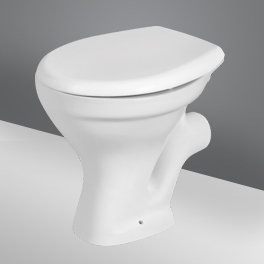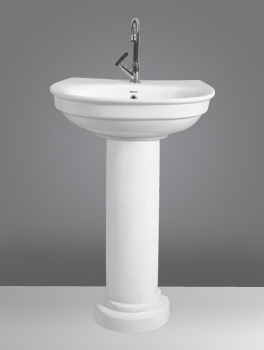
There are many different types of wash basins to choose from. You need to consider the needs of your bathroom and how you plan on using it before you choose one.
Choosing the right materials can make all the difference in your wash basin’s durability and ease of cleaning. Here are some of the most common materials used in making wash basins:
1. Ceramic
When you think of a toilet, you might picture porcelain or ceramic. Both are commonly used for sanitary ware, but they have different properties that can make them more or less desirable.
Porcelain is an extremely hard and durable material that’s commonly used in bathroom basins. It’s also scratch resistant and easy to clean. It’s a great choice for people who want a durable wash basin that will last a long time.
Ceramic is a type of clay that’s typically fired at high temperatures in a kiln to make it durable and chip-resistant. It can be molded into a variety of shapes and is also available in various colors.
To make a ceramic sink, a mixture of clay, powdered glass and other ingredients is mixed together. The resulting slurry is then poured into a production line where it’s fed into a series of molds.
These molds are then inserted into a kiln to be fired at high temperatures, causing the ceramic to become a hard, dense and durable material. This process is repeated multiple times until the desired shape and color are achieved.
Vitreous china is a coating that is often added to porcelain and other ceramic materials. This coating is not toxic and is usually applied on top of a ceramic surface that has already been coated with enamel.
Using this coating, manufacturers can create a beautiful glazed surface on the toilets and other sanitary ware they manufacture. In addition to making the ceramics look beautiful, this process allows them to make their products much more durable and resistant to scratches.
It’s important to remember that these types of coatings aren’t made from toxic substances or any other dangerous chemicals, but it’s a good idea to do your research before you decide which ceramic you want for your sanitary ware.
Ceramic sanitary ware is one of the most popular types of toilets, washbasins and other bathroom fixtures. It’s a durable and low-maintenance alternative to stainless steel, which can be heavy and difficult to handle. It’s also very inexpensive and easy to install. It’s also a good choice for bathrooms where space is at a premium.

2. Porcelain
Porcelain is a ceramic material that is often used in making water closets and wash basins. It is a durable and hardy material that resists scratches and chipping, and it is also easy to clean.
This type of porcelain is made from a mix of materials, including kaolin, bone ash and quartz (silica). It has high strength and is resistant to heat and chemical shocks.
The process for manufacturing porcelain includes crushing and purifying the raw materials, mixing them together and then going through a number of forming processes before firing the body. These forming processes can include soft plastic forming, stiff plastic forming, pressing or casting.
After the body is formed, it is fired and may be glazed. Glazing is the process of applying a layer of decorative glass to the surface of a porcelain body before it is fired again.
In addition to these forming processes, the material is usually subjected to a final purification process called bisque-firing before it is finished. It can then be re-fired at a higher temperature before being polished and glazed again for its final appearance.
There are several different types of clays that can be used for making porcelain, but kaolin is the most commonly used. Other types of clays include ball and china clay.
Some porcelains are also a mixture of paper clay, which is a form of plastic clay that helps improve formation issues and cracks. Unlike kaolin, paper clay does not contain calcium.
Other materials that can be used in porcelain include feldspar, which is a type of rock composed of flint and aluminum silicate. It can be mixed with other minerals to increase workability and fire at a lower temperature.
Another type of porcelain is hard paste porcelain, which originated in China and was made from a combination of petuntse and kaolin. This type of porcelain is highly durable and has a strong white color and a slightly blue tone.
This type of porcelain is often more expensive than other materials and is a better choice for people who want a beautiful, high-quality product that will last a long time. However, it is not always easy to care for and can be susceptible to scratches. It is best to avoid exposing your porcelain sink or tub to hard water and other chemicals, as it can lead to a buildup of stains that will make your sink look dirty and dull over time.
3. Enameled Steel
Enameled steel is a durable material that can be used in a variety of applications, including water closets and wash basins. It is resistant to corrosion, has excellent hygienic properties, and is easy to clean. It is also an extremely versatile material that can be used in a wide range of other applications, such as signage and kitchen appliances.
Enamel is a thick glassy inorganic coating that is applied to a steel substrate via thermal fusion. The coating provides a high degree of resistance to a range of environmental conditions and can be custom-made to the exact needs of each application.
The enamelling process usually includes several steps, including (i) preparing the metal surface after forming, (ii) applying the enamel, (iii) drying and firing at high temperatures to fuse the enamel. Different types of enamel are available, depending on the type of end use and final appearance required.
Ground-coat enamel is a common choice for the two-coat/one-fire enamelling process because it contains an alloy of Co and Cu oxides that promote adhesion to the steel surface. The coating protects the steel from corrosion and allows enamel to be applied without the need for pickling or other pre-treatments.
Cover-coat enamel is also available in a variety of colours and finishes. The most common opacifiers and colouring agents are titanium dioxide (TiO2), antimony oxide (Sb2O5), zirconium oxide (ZrO2) and tin oxide (SnO).
In addition to providing a decorative look to the surface, these coatings can also offer many practical benefits. They are resistant to abrasion, heat and chemical attack and can be custom-made to suit each application.
The abrasion resistance of the coatings can be improved by adding mill additives such as quartz and potassium feldspar. This is done to reduce the concentration of the melting oxides and so increase the abrasion resistance while still maintaining the aesthetic properties of the coating.
Abrasion tests can be performed using a variety of methods, such as bending and microscopic observation. These methods allow the coating to be analyzed in detail and provide insight into the mechanical properties of the material.

4. Acrylic
Acrylic materials have many benefits when it comes to making bathroom products. They are durable, sanitary, and easy to clean. They are also available in a variety of different colors and finishes. Whether you are looking for something modern or traditional, there is an acrylic material that will suit your needs.
Acrylic sinks are made from a lightweight material that is resistant to scratches and heat. They are also easy to clean and are resistant to stains and mildew.
They come in a variety of shapes and sizes, and they are easy to install. They are also available in a variety colors and designs, so you can find a wash basin that will match your bathroom’s decor.
Ceramics are very tough and durable materials that can last for a long time. They are also very easy to clean and are resistant to stains, mold, and mildew. However, they are not always the most stylish option for your bathroom.
If you are looking for a more contemporary look, you can opt for stainless steel. This will give your bathroom a sleek and stylish look that is sure to stand out in any room.
Stainless steel is more durable than other options, but it can be difficult to maintain and can break if left in rough conditions. Therefore, it is best to opt for other options if you want something that will be easy to maintain and care for.
Porcelain is another material that is commonly used in the production of bathroom accessories. It is a durable material that is resistant to dents, scratches, and damage from impacts. It is also resistant to staining, as a combination of hot water and baking soda will quickly remove most stains.
The only downside to using porcelain is that it can be difficult to find fixtures that match your tastes and preferences. Additionally, they can be very expensive.
Acrylic is a type of ceramic that is similar to ceramic but is less expensive. It is a versatile material that can be used for almost any application. It is lightweight and slick, which makes it an ideal choice for a bathroom. It is also easy to clean and can be painted with acrylic paints to give it a unique appearance.
Make an Appoinment
Send us Message
Visit us at Address
Vagadiya Road, Thangadh - 363530,
Gujarat, India.
Gujarat, India.
© Copyright 2024, Orient Ceramics, All Rights Reserved.
Web Design & Development by Opal Infotech